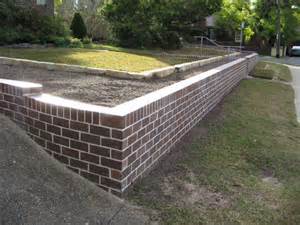 Brick retaining walls serve multiple functions in your yard or landscaping. They can be used to add emphasis to a particular area (landscape design), serve as a barrier (security) or simply to add support to an embankment (functional/structural).
Brick retaining walls serve multiple functions in your yard or landscaping. They can be used to add emphasis to a particular area (landscape design), serve as a barrier (security) or simply to add support to an embankment (functional/structural).
Here are 5 benefits to installing a brick retaining wall:
- Providing functional support for keeping soil in place
- Eliminating the eye sore of dirt piles and hills
- Helpful in preventing flooding and erosion
- Serves as a barrier and gives added security, depending on the height
- Prevent damage to property or surrounding structures
Above all, a retaining wall holds back soil from a building or structure. Retaining walls prevent downward movement and provide support grade changes.
Brick retaining walls can serve aesthetic and landscape design functions as well. A retaining wall installation will most certainly enhance the value of your home and property, as well.
Retaining walls can also be used to turn unusable inclines into attractive and useable terraces. By utilizing layered walls, or even a single retaining wall to create flat ground, you can use the walled off area as a stylish planter or even have it paved to function as a patio.
Cleaning Brick Retaining Walls
Once a year use a garden hose with a spray nozzle to remove any loose dirt. If there is a particular area that requires little to no sunlight, be on the lookout for moss, mold, or mildew – all of which should be nipped in the bud seasonally.
A solution of one cup bleach mixed with a gallon of water can be applied to these areas with a scrub brush, but apply this mixture after soaking down the brick first. Use a natural or synthetic brush – wire brushes can leave traces of steel behind that will rust and discolor the brick.

